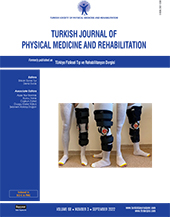Comparison of the effectiveness of conventional physical therapy and extracorporeal shock wave therapy on pain, disability, functional status, and depression in patients with chronic low back pain
2 Department of Physical Medicine and Rehabilitation, Marmara University Faculty of Medicine, Istanbul, Türkiye
3 Department of Physical Medicine and Rehabilitation, Kırşehir Ahi Evran University Faculty of Medicine, Kırşehir, Türkiye DOI : 10.5606/tftrd.2022.8905 Objectives: The aim of this study was to compare the effectiveness of conventional physical therapy (transcutaneous electrical nerve stimulation, hot pack, and therapeutic ultrasound) and extracorporeal shock wave therapy (ESWT) on pain, disability, functional status, and depression in patients with chronic low back pain (LBP).
Patients and methods: Ninety-one patients with chronic LBP were included in the study and randomized to groups that received ESWT or conventional physiotherapy; of these, 70 completed the study (37 males, 33 females; mean age: 46.4±13.3 years; range, 18 to 65 years). Outcome measures included the Visual Analog Scale, the pressure pain algometer, Oswestry Disability Index (ODI), Health Assessment Questionnaire (HAQ), fingertip-to-floor distance, and the Beck Depression Inventory. The assessments were made before treatment and at the first and 12th weeks after treatment.
Results: Extracorporeal shock wave therapy was more effective than conventional physical therapy in terms of Visual Analog Scale scores, the pressure algometer, ODI, HAQ, and fingertip-to-floor distance at the first and 12th week.
Conclusion: Extracorporeal shock wave therapy is superior to conventional physical therapy in terms of improving pain, spinal mobility, and functional status in patients with chronic LBP.
Keywords : Chronic low back pain, conventional physical therapy, extracorporeal shock wave therapy, functional status

















